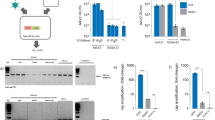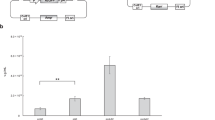Abstract
It is difficult to establish stable packaging cell lines producing retrovirus vectors for the expression of anti-oncogenes with cytotoxic or cytostatic potential, because these genes would also affect the growth of the packaging cell lines. To overcome this problem, we designed a transcriptional unit pBabeLPL for vector RNA production, in which the transcription of the exogenous genes is completely suppressed by the presence of a preceding insertion containing the puromycin resistance gene (puro) and a poly(A) addition signal. This insertion is flanked by a tandem pair of loxP, and is designed to be excised after the introduction of Cre recombinase, when transcription of the exogenous gene will be started from the 5′-LTR. The transcriptional unit car- rying LacZ or p53 as the exogenous gene was introduced into a previously constructed prepackaging cell lines PtG-S2, in which the expression of VSV-G is also designed to be initiated by the introduction of Cre recombinase, while the gag-pol gene is expressed continuously. After the introduction of Cre recombinase by an adenovirus vector, LacZ- or p53-expressing VSV-G-pseudotyped retrovirus vectors with the designed structure were produced at high virus titers. The p53 virus was shown to be able to transduce p53 into the entire population of several human cancer cell lines and to induce their growth arrest at the G1 phase, indicating that this vector-producing system will be advantageous for human gene therapy.
This is a preview of subscription content, access via your institution
Access options
Subscribe to this journal
Receive 12 print issues and online access
$259.00 per year
only $21.58 per issue
Buy this article
- Purchase on Springer Link
- Instant access to full article PDF
Prices may be subject to local taxes which are calculated during checkout






Similar content being viewed by others
References
Miller AD . Human gene therapy comes of age Nature 1992 357: 455–460
Mulligan RC . The basic science of gene therapy Science 1993 260: 926–932
Vile R, Russell SJ . Gene transfer technologies for the gene therapy of cancer Gene Therapy 1994 1: 88–98
Burns JC et al. Vesicular stomatitis virus G glycoprotein pseudotyped retroviral vectors: concentration to very high titer and efficient gene transfer into mammalian and nonmammalian cells Proc Natl Acad Sci USA 1993 90: 8033–8037
Yee JK et al. A general method for the generation of high-titer, pantropic retroviral vectors: highly efficient infection of primary hepatocytes Proc Natl Acad Sci USA 1994 91: 9564–9568
Matsubara T et al. Pantropic retroviral vectors integrate and express in cells of the malaria mosquito, Anopheles gambiae Proc Natl Acad Sci USA 1996 93: 6181–6185
Sharma S, Cantwell M, Kipps TJ, Friedmann T . Efficient infection of a human T cell line and of human primary peripheral blood leukocytes with a pseudotyped retrovirus vector Proc Natl Acad Sci USA 1996 93: 11842–11847
Arai T et al. A new system for stringent, high-titer vesicular stomatitis virus G protein-pseudotyped retrovirus vector induction by introduction of Cre recombinase into stable prepackaging cell lines J Virol 1998 72: 1115–1121
Yang Y et al. Inducible, high-level production of infectious murine leukemia retroviral vector particles pseudotyped with vesicular stomatitis virus G envelope protein Hum Gene Ther 1995 6: 1203–1213
Chen ST et al. Generation of packaging cell lines for pseudotyped retroviral vectors of the G protein of vesicular stomatitis virus by using a modified tetracycline inducible system Proc Natl Acad Sci USA 1996 93: 10057–10062
Ory DS, Neugeboren BA, Mulligan RC . A stable human-derived packaging cell line for production of high titer retrovirus/vesicular stomatitis virus G pseudotypes Proc Natl Acad Sci USA 1996 93: 11400–11406
Estreicher A, Iggo R, Roth JA . Retrovirus-mediated p53 gene therapy Nature Med 1996 2: 1163
Kanegae Y et al. Efficient gene activation in mammalian cells by using recombinant adenovirus expressing site-specific Cre recombinase Nucleic Acids Res 1995 23: 3816–3821
Kanegae Y et al. Efficient gene activation system on mammalian cell chromosomes using recombinant adenovirus producing Cre recombinase Gene 1996 181: 207–212
Niwa H, Yamamura K, Miyazaki J . Efficient selection for high-expression transfectants with a novel eukaryotic vector Gene 1991 108: 193–200
Choulika A, Guyot V, Nicolas JF . Transfer of single gene-containing long terminal repeats into the genome of mammalian cells by a retroviral vector carrying the cre gene and the loxP site J Virol 1996 70: 1792–1798
Russ AP, Friedel C, Grez M, von Melchner H . Self-deleting retrovirus vectors for gene therapy J Virol 1996 70: 4927–4932
Bergemann J et al. Excision of specific DNA sequences from integrated retroviral vectors via site-specific recombination Nucleic Acids Res 1995 23: 4451–4456
Fernex C, Dubreuil P, Mannoni P, Bagnis C . Cre/loxP-mediated excision of a neomycin resistance expression unit from an integrated retroviral vector increases long terminal repeat-driven transcription in human hematopoietic cells J Virol 1997 71: 7533–7540
Wildner O et al. Generation of a conditionally neor-containing retroviral producer cell line: effects of neor on retroviral titer and transgene expression Gene Therapy 1998 5: 684–691
Vanin EF et al. Development of high-titer retroviral producer cell lines by using Cre-mediated recombination J Virol 1997 71: 7820–7826
van Deursen J, Fornerdo M, van Rees B, Grosveld G . Cre-mediated site- specific translocation between nonhomologous mouse chromosomes Proc Natl Acad Sci USA 1995 92: 7376–7380
Baker SJ et al. Suppression of human colorectal carcinoma cell growth by wild-type p53 Science 1990 249: 912–915
Cai DW et al. Stable expression of the wild-type p53 gene in human lung cancer cells after retrovirus-mediated gene transfer Hum Gene Ther 1993 4: 617–624
Fujiwara T et al. A retroviral wild-type p53 expression vector penetrates human lung cancer spheroids and inhibits growth by inducing apoptosis Cancer Res 1993 53: 4129–4133
Fujiwara T et al. Therapeutic effect of a retroviral wild-type p53 expression vector in an orthotopic lung cancer model J Natl Cancer Inst 1994 86: 1458–1462
Xu M et al. Parenteral gene therapy with p53 inhibits human breast tumors in vivo through a bystander mechanism without evidence of toxicity Hum Gene Ther 1997 8: 177–185
Favrot M, Coll JL, Louis N, Negoescu A . Cell death and cancer: replacement of apoptotic genes and inactivation of death suppressor genes in therapy Gene Therapy 1998 5: 728–739
Polyak K et al. Genetic determinants of p53-induced apoptosis and growth arrest Genes Dev 1996 10: 1945–1952
Freeman SM et al. The ‘bystander effect’: tumor regression when a fraction of the tumor mass is genetically modified Cancer Res 1993 53: 5274–5283
Mesnil M et al. Bystander killing of cancer cells by herpes simplex virus thymidine kinase gene is mediated by connexins Proc Natl Acad Sci USA 1996 93: 1831–1835
Morgenstern JP, Land H . Advanced mammalian gene transfer: high titre retroviral vectors with multiple drug selection markers and a complementary helper-free packaging cell line Nucleic Acids Res 1990 18: 3587–3596
Dranoff G et al. Vaccination with irradiated tumor cells engineered to secrete murine granulocyte–macrophage colony-stimulating factor stimulates potent, specific, and long-lasting anti-tumor immunity Proc Natl Acad Sci USA 1993 90: 3539–3543
Acknowledgements
We thank Yuriko Yoshikawa for assistance in preparing the manuscript. This work was supported in part by grants and endowments from Eisai Co, Ltd, and by a Grant-in-Aid for Scientific Research on Priority Areas from the Ministry of Education, Science and Culture, Japan.
Author information
Authors and Affiliations
Rights and permissions
About this article
Cite this article
Ui, M., Takada, M., Arai, T. et al. Retrovirus vectors designed for efficient transduction of cytotoxic or cytostatic genes. Gene Ther 6, 1670–1678 (1999). https://doi.org/10.1038/sj.gt.3301009
Received:
Accepted:
Published:
Issue Date:
DOI: https://doi.org/10.1038/sj.gt.3301009
Keywords
This article is cited by
-
SWI/SNF complex is essential for NRSF-mediated suppression of neuronal genes in human nonsmall cell lung carcinoma cell lines
Oncogene (2006)
-
Introduction of wild-type patched gene suppresses the oncogenic potential of human squamous cell carcinoma cell lines including A431
Oncogene (2002)
-
Efficient in vitro and in vivo gene regulation of a retrovirally delivered pro-apoptotic factor under the control of the Drosophila HSP70 promoter
Gene Therapy (2001)



